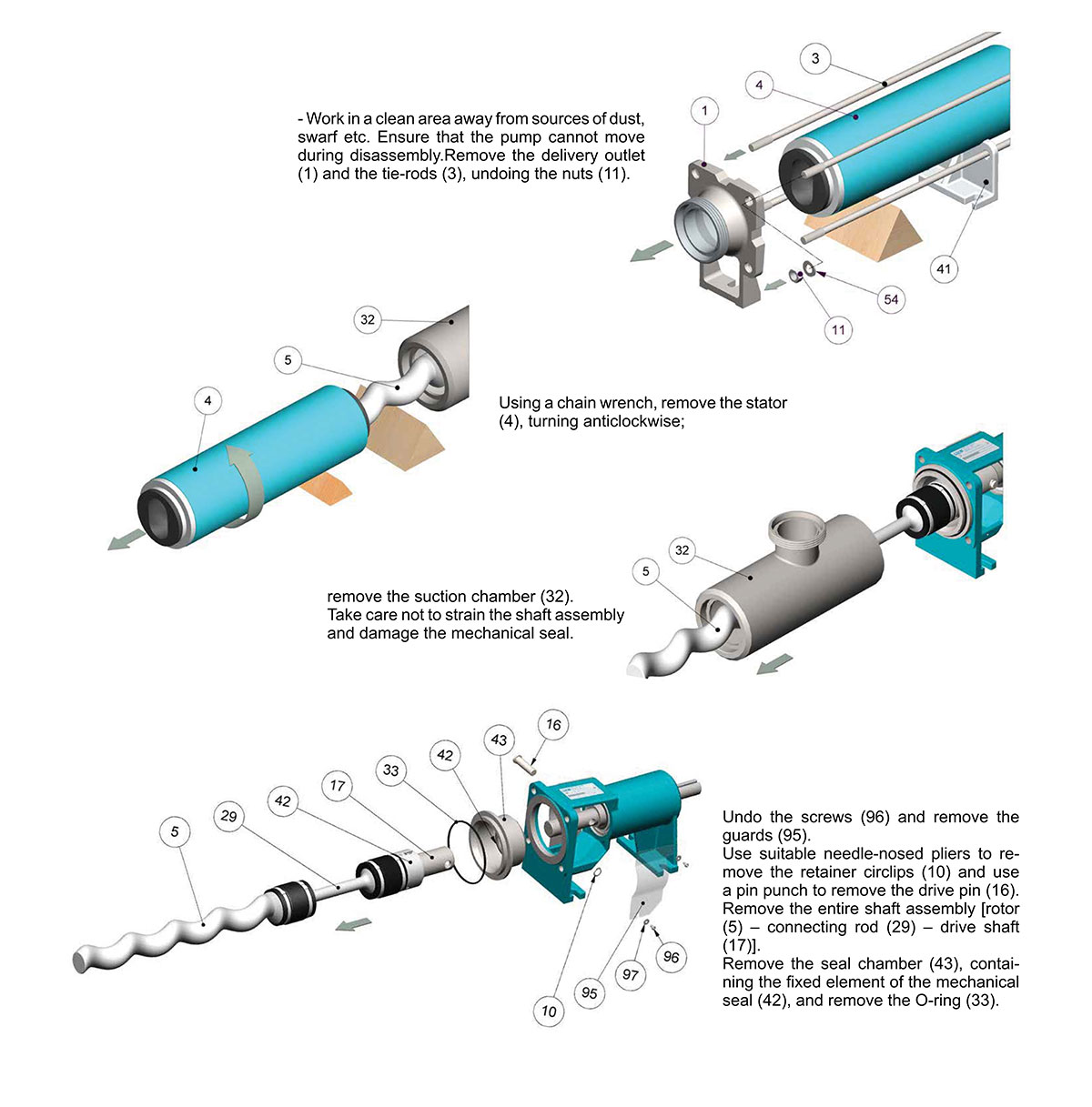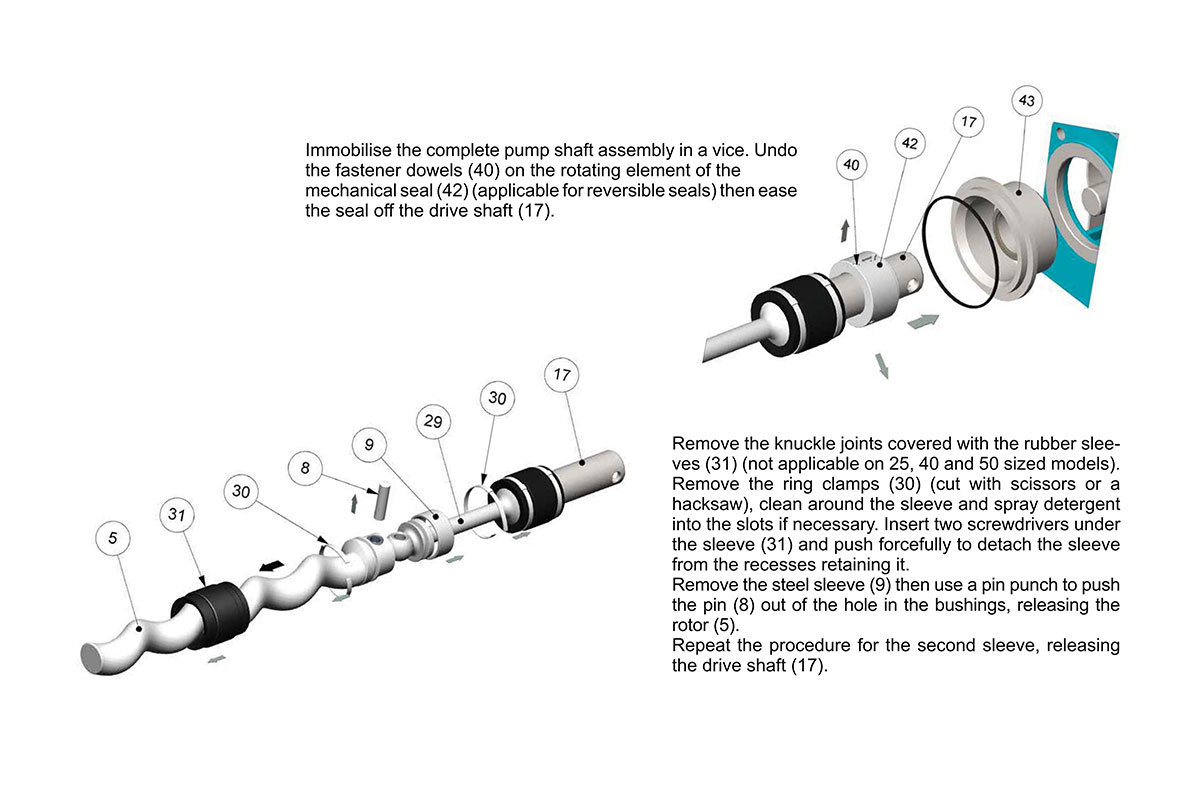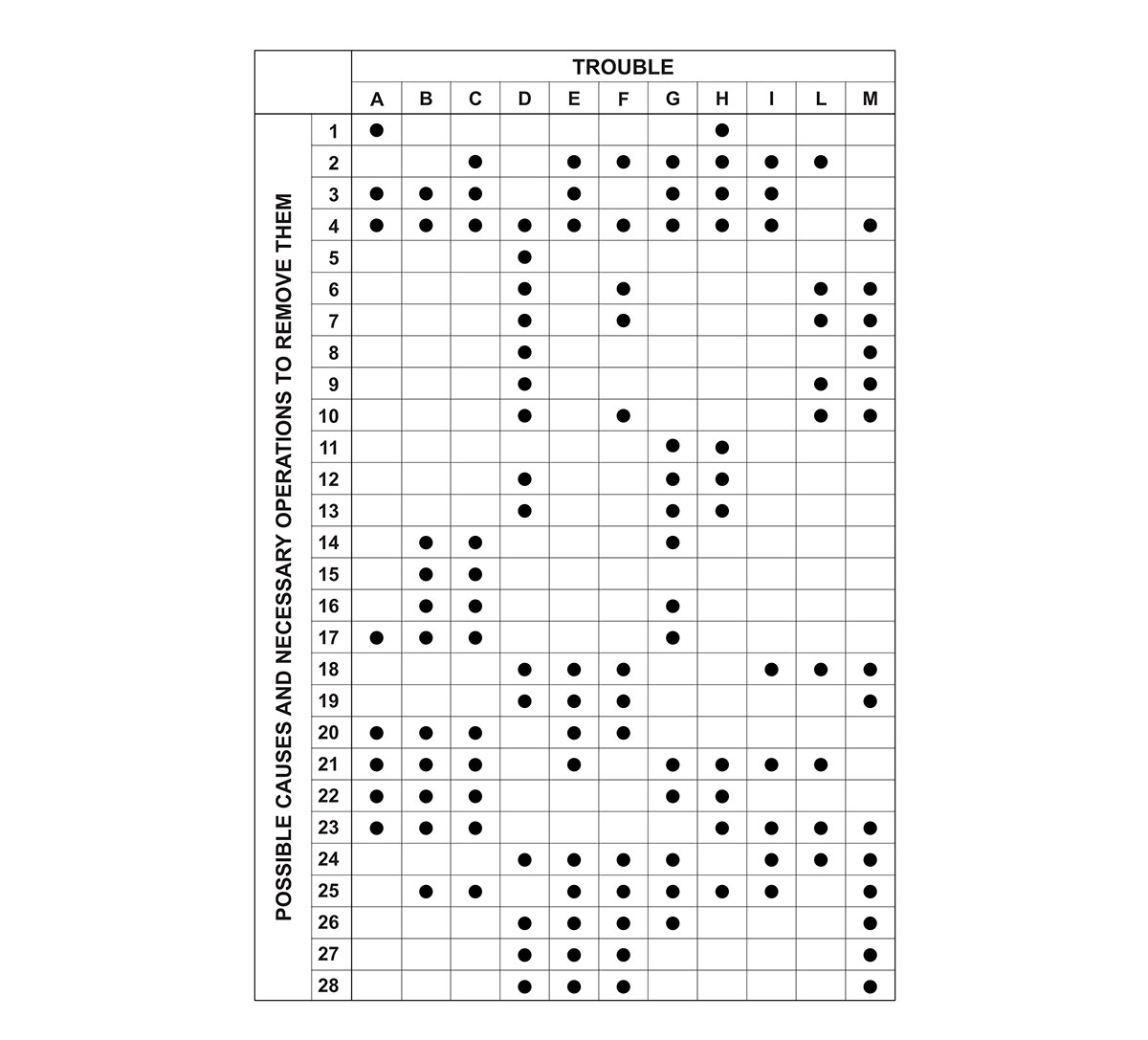-
PRELIMINARY OPERATIONS
-Check the direction of rotation indicated on the pump.
-The suction pipeline and pump must be filled with liquid; it is possible to distinguish two cases:
a) When the pump must work with a negative suction height, fill the pump by filling liquid in its pipelines.
b) When the pump must work with a positive charge, open suction, and outlet valves until the manometer on the outlet side of the pump indicates a pressure corresponding to the positive suction charge.
The pump must never run dry; only a few seconds of dry working are enough to damage the stator.
-if the seal box is externally cooled, open the cooling water feeder and adjust the water circulation.
-Check that suction and outlet y alves are completely opened.
The progressive cavity pump is a volumetric pump and, as a result, must never run with a closed valve on the delivery pipe.
The single-screw progressive cavity pump is a volumetric pump capable of producing theoretically infinite pressure. If the delivery pipe is closed, the pressure generated by the pump may exceed the maximum pressure limits for the system. Installing adequate safety devices such as pressure switches and bypasses is recommended.
-Start the pump and check the direction of rotation again.
Disassembly video reference
1.Dismantling a standard SEEPEX stator
2. NETZSCH NEMO® Progressing cavity pump Disassembly
3.PCM progressive cavity pump maintenance
4.How to Assembly Progressing Cavity Pump
-
MAINTENANCE
1. STATOR INSPECTION
WARNING The pump must be checked for wear after 700-1000 operating hours. The frequency of subsequent inspections is determined in relation to the degree of wear noted – however, the interval between inspections must not exceed 1500 operating hours.


-
WORKING IRREGULARITIES
We are herewith listing some of the possible working irregularities that may occur using the pumps, with a table allowing us to find out the possible causes and the way to remove the trouble.
The trouble:
-pump not turning because:
A)it does not start
B)it gets locked
C) the magneto-thermic switch releases
-pump turning but:
D) it does not self prime
E) delivery is inadequate
F)flow is not uniform
G) The pump is noisy
H) The stator gets worn out too quickly
l) The rotor gets worn out too quickly
L) shaft seal leaks
M) outlet pressure is poor.

Possible causes and necessary operations to remove them:
1) The pump being new, there is too much friction or the rotor gets stuck on the stator.
– Fill the pump, if necessary with lubricating liquid, and make it turn manually by means of a suitable too
2) Outlet pressure is too high.
– Check pressure by means of a manometer and compare it with the features mentioned in your order.
– Check that there are no obstructions along outlet pipelines.
3) The stator got swollen and it does not withstand the product to be pumped.
– Check if the pumped product corresponds to the one mentioned in your order. Change stator material.
4)The product to be pumped contains too big solid particles.
– Increase liquid percentage and reduce the dimension of solid particles. install a bigger pump.
5) The inlet pipeline is obstructed.
– Remove the obstruction and take measures to avoid the formation of other obstructions.
6) O-rings of the mechanical seal are damaged.
– Change 0-rings. Check the compatibility of 0-rings material with the product to be pumped. in this case, change the 0-rings material.
7)Mechanical seal rings have seized.
– Change rings. in case, use rings made of a material, which is more suitable to the product to be pumped.
8) The direction of rotation is wrong.
– Change the electric connection.
9) The gland seal does not fit the product to be pumped.
– Change the packing gland seal with a different type.
10)Packing gland seal compression is badly adjusted.
– Adjust compression: in case change packing gland seal.
11) The pump is turning too fast.
– Reduce revolution number. In case you want to get the same delivery, use a bigger pump.
12) The product to be pumped is too viscous
– Increase temperature, avoiding inlet cavitation.
13) The product to be pumped is too heavy.
– Dilute it by means of a lighter fluid or use a more powerful motor.
14)Articulated joints are worn out.
– Change worn-out parts and grease the joints by means of adequate grease.
15) The pump and motor are not aligned.
– Reset alignment.
16) The coupling joint is damaged.
– Change damaged parts, taking care not to alter the pump-motor alignment.
17)Rolling bearings are damaged.
– Change and lubricate bearings, if the product temperature is very high, increase bearing slack and use a lubricator suitable for high temperatures.
18) The stator is damaged.
– Change stator. Check the compatibility of stator material with the product to be pumped. in case, change stator material.
19) The rotor is worn out.
– Change rotor. In case, change rotor material or coating.
20) The motor works in two phases.
– Electric features of the motor do not correspond to network features. Check the electric system and electric features of the motor.
21)The product is too hot and there are dilatations of the stator.
– if it is not possible to decrease the product temperature, install a rotor with a smaller diameter.
22)A foreign body got into the pump
-Take the foreign body off and check if the rotor and stator got damaged.
23) With the pump stopped the product to be pumped gets hard or settles
– Clean the pump and repeat cleaning after every working cycle.
24) Inlet suction is too high (available NPSH is lower than requested NPSH).
– Reduce the inlet losses of charge, install the pump in the lower level (increase available NPSH)
25) Pump is working dry
– Fill the pump and install a dry running protection device.
26)Air is getting into the suction pipeline.
– Increase the level of product in the suction intake, eliminate vortexes in the inlet, check the seal, and check for air infiltration via the pipe unions.
27) The pump is turning too slowly.
– Instal an adjustment device and increase the revolution number.
28) By using reduced diameter rotors, the working temperature is not reached
-Heat the stator and set it to a working temperature.
-
WASHING CYCLE FOR PUMPS USED TO HANDLE FOODSTUFF PRODUCTS
WARNING
Pumps intended for handling foodstuff products must be thoroughly cleaned be in place) the procedure is carried out to clean the pump.
CIP PROCEDURE
1) Wash with clean water to empty the pump of any product
2) Basic wash with 1 to 2% solution of caustic soda at 60 to 80℃ for approximately 10 to 20 minutes
3) Intermediate wash with clean water for 5 to 10 minutes
4)Wash with 1 to 1.5% solution of nitric acid at 50 to 70°C for 5 to10 minutes
5)Final wash with clean water for approximately 10 minutes
NB: The flow rate of the cleaning fluids used must not be less than 1.5m/sec.
During the CIP cycle, the stator is subjected to significant chemical and thermal stress. As a result, the pump should be run in short bursts (2 to 4 starts per minute lasting just 1 or 2 revolutions) . This will clean the interior of the pump while limiting mechanical stress.
